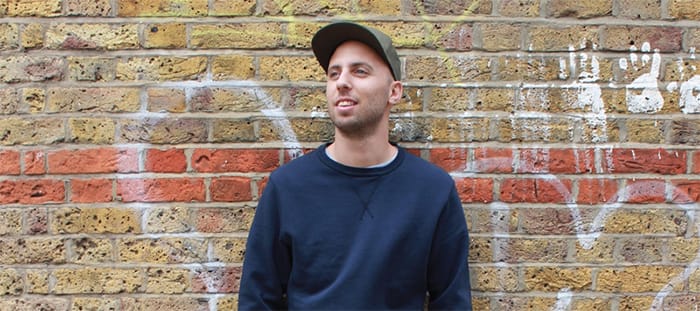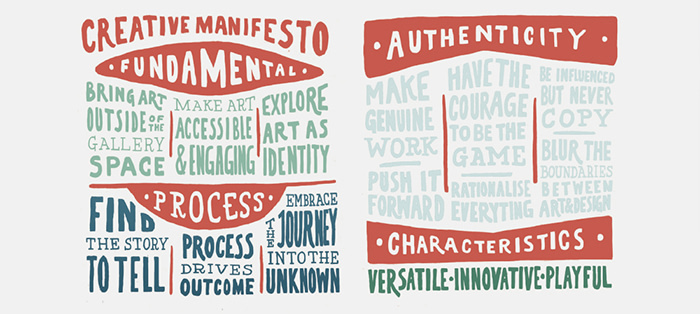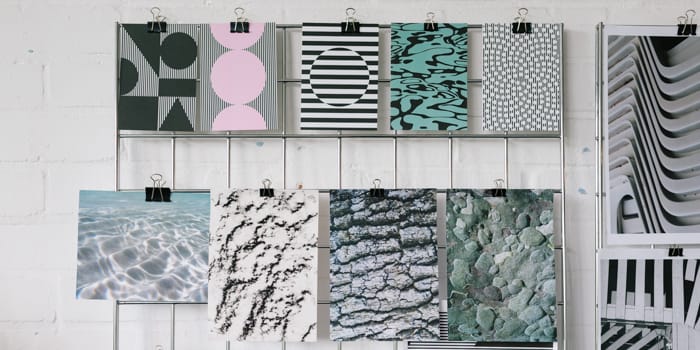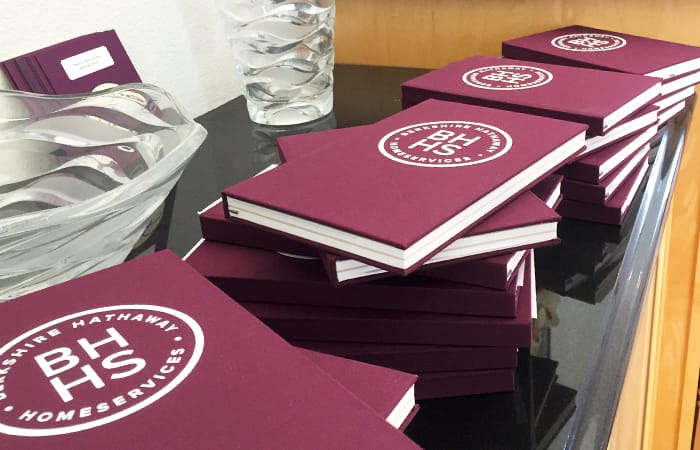How Acrylicize brings art outside of the gallery
The story of how one art student transformed his university art project into a global business.

The story of how one art student transformed his university art project into a global business.
The seed of Acrylicize was planted when James Burke, the design studio’s founder, was in a college art class. His professor questioned if his project–– a piece of graffiti–– was actually art. This challenge formed strong roots in Burke’s brain. As a result, his final college project was about making art less dependent on gallery space, and more accessible to the masses.
“Part of my final degree was acrylic pictures on walls, which were designed to communicate the idea of art as commodity,” Burke told MOO. “I hung price tags from the work, not to sell the work, but to reinforce the idea of art has having a tangible quality to it… And everyone wanted to buy the pieces.”
This success made Burke resistant to let go of the project after graduation. He felt that he was truly learning how to connect people with the art world.

“The mother of all pitches”
Burke believed in this mission so strongly that he decided to build a business around the concept with one of his best friends, Paul Arad. Burke took care of the conceptual narratives of their projects, while Arad found people who were interested in buying the work. “ We are a team and we’ve been a team ever since,” Burke said. “We are very different from each other and that’s why it works so well.”
The dynamic duo got their first big break when they pitched an acrylic panel product to put on the walls of Wembley Stadium, then in construction. Their dream was to tell the stories of what had happened previously on the grounds, and pair them alongside modern-day images. As Acrylicize says on their website, the two outlined “the significant role art and photography could play in infusing the new stadium with the spirit of the old hallowed turf.”
Despite their lack of experience–– and because of their huge amount of passion–– the two won the pitch.“ That’s when we realized that art has the amazing ability to tell stories and to articulate the essence of a particular brand,” Burke said.
Mixing advertising and art
From that point on, Acrylicize focused on using art to tell stories. “For a brand, that might be about how you engage your workforce,” Burke explained. There is a story behind every company, and Burke argues that illustrating a company history for employees can help them feel more connected to the brand. “The design aspect of our work is storytelling,” Burke said.

This mindset transfers over into the brainstorming process for the Acrylicize studio, as well. Since the team is collectively searching for the right story to tell, creativity is key.
“If we are working for a brand, we go through a series of workshops getting to know them and connecting with them on a human level. We find the essence of the brand,” Burke said. “If it’s for a public art piece, it’s about understanding the area and the heritage and searching for those stories to tell.”
Since the Acrylicize team comes from a variety of artistic backgrounds–– fine art, fashion, architecture, graphic design, and more–– their work has a unique and multi-dimensional quality. This is furthered by the company’s collaborative approach, which includes learning a new artistic skill or technique together once per week. “Having the opportunity to play and get lost in something new is really important for our creativity,” Burke said.
Building out the brand
Acrylicize has expanded from London to Seattle–– which means learning how to keep the culture consistent across multiple locations. Yet Burke wasn’t too worried about controlling that process. He trusted that the team would unfold as it was meant to.”I’m someone who believes that you should let the universe take you along on a journey,” Burke said.
Believe it or not, part of that journey was MOO business cards. “ It’s genuinely the perfect product for us,” Burke said. “It’s basically our portfolio. Our whole thing is that no two projects are ever the same. So whenever we showcase anything involving our studio, we have to show a range of projects to get our story across.”
Using printfinity, the Acrylicize team’s business cards showcase 25 different pieces on them. “ When we give out our business cards, we ask the person to pick their favorite one,” Burke said.” They immediately engage with our projects and see which ones resonate with them the most. It turns into a game and interaction with our brand in a unique way. We are absolutely delighted by them.”
Tell your brand story with MOO Business Services
At MOO, we’ve been helping people make their mark in the world with amazing quality print products for over a decade. And as our customers have grown, so has our service offering. That’s why for bigger businesses—with 10+ employees—we now offer MOO Business Services. It’s MOO + benefits. MOO Business Services combines dedicated account management with an easy online ordering platform and expert design services. It’s a complete package for businesses to give you more brand control and consistency—while saving you time, stress, and money in the process.
Fill out the form here and a friendly Account Manager will reach out to you.
Got a great idea but unsure how to bring it to life? Keep projects moving and remove roadblocks with Seth Godin’s “Focus: A Ship It Journal”.
Sometimes a great idea can get lost in the brainstorming process. Or the nitty-gritty details can dim the spark of inspiration you started out with. It’s true—great ideas take work. And bringing your work to the world takes organization before you ship it.
So, what does it mean to “ship” your work? Put it in the mail? A nautical journey? Well, metaphorically speaking…sure. But here, it’s the process of moving your complex vision along into reality with some simple, yet effective ideation and planning. Without structure and guidance, an idea can remain just that—an idea. That’s where best-selling author, speaker, thinker, and veteran shipper, Seth Godin comes in.
MOO meets Seth Godin
Seth Godin is the New York Times bestselling author of 18 books, and has made a name for himself in the world of ideas in the past few years. He became widely known for his book, The Purple Cow, which was a guide for businesses of all sizes to think about the ways to stand out in a saturated market. Seth has also hosted a viral TED Talk about how to get your ideas to spread.
His latest book is a partnership with MOO, called “Focus: A Ship It Journal”, which brings his ship-it methods to a broader audience.
Bring your project into focus
With the Ship It Journal, Godin set out to provide a structured approach for managing projects of all shapes and sizes. While notebooks are a great tool for getting there, the blank page can be intimidating. “I think that an organized journal can give people the foundation they need to create ever better work,” Godin says.
A new way to ship great ideas
Teaming up with MOO, Seth Godin has brought the Ship It Journal back—and it’s better than ever. “Focus: A Ship It Journal” is a workbook that only comes to life after you start writing in it.
If you loved our Hardcover Notebooks you’re in luck. The Ship It Journal has the same lay-flat design, swiss binding and premium Munken Kristall paper. And now, all that goodness comes with Seth’s step-by-step guidance to keep your projects moving—brilliantly simple (and simply brilliant).
“The moment you write something down, it’s more real than it was just a moment ago,” Godin tells MOO. “So if you have an idea that matters, it probably matters enough to start writing it down.”
But where does the shipping process begin? To start, the workbook allows ample room to define your ideas by putting them to paper. (Seth suggests you write in pen, because no idea worth shipping is too bold to erase later.)
And, to make sure your vision reaches its maximum potential, the idea generation section tackles everything from defining the shape and scope of your project, identifying the key players for making it happen, and how to overcome those unexpected problems that may arise—because, hey, you never know.
The Notebook works for week-long solo projects and complex projects that involve dozens of people and millions of dollars. No matter how big or small the project, Godin offers key advice to guide you through.
Design meets functionality
MOO had the honor of designing a workbook for one of the most admired contemporary marketing gurus, which is no small feat. Luckily, Seth’s words and ideas inspired the MOO design team to bring them to life in beautiful (and useful) design spreads.
According to MOO’s Head of Design, Sarah Daley, the team focused on using large type as a design element, which puts the content into the spotlight across the spread. “Throughout the workbook,” Sarah explains, “simple geometric shapes speak to the process of taking things apart, and putting them back together again. This illustrates the key theme of focus, forward motion, and project milestones.”
Whether you’re just starting out on a small business venture, or organizing your team to embark on the next big project—the Ship It Journal is the perfect companion to go from idea to “I did it.”
Order your “Ship It Journal” and bring your ideas to life
PATTERNITY founders Anna and Grace share their unique worldview and love of pattern through workshops, passion projects and high-profile collaborations.
Anna Murray and Grace Winteringham see pattern in everything. Their work spans projects from homeware ranges to architectural projects. We spoke to them about their latest partnership, which aims to connect us all.
At the heart of PATTERNITY — a ‘conscious creative organization’ that explores the role of pattern in our lives — are the seen and unseen shapes that are all around us, from a spiralling galaxy to the lines of a high-rise.
Anna and Grace’s unique philosophy also embraces the patterns of thought, being and behavior that connect us. “Everything we do creates a pattern, which in turn affects everything else in our lives, creating ripples upon ripples,” Anna explains.
In their light, bright studio in Hackney, East London, an abundance of greenery offsets the PATTERNITY team’s monochrome representations of stripes, squares, triangles and circles — the key shapes seen in nature, and which inform their striking designs.
MOO met the passionate pair to discuss the ideal workspace, their approach to collaboration, and the patterns that surround us.
How did you decide to partner up?
Grace: When we met in 2009, we both had flip files of pictures and magazine tears. Comparing them, we saw it was really similar stuff — images like cracks in paving slabs compared with the patterns on a giraffe’s skin.
We were both quite bold and graphic in the designs we liked, and also enjoyed looking at the details of nature. Pattern was the common thread, which is when we realized we were both obsessed with the same thing.
Anna: There was also something deeper in that we wanted to create a business that had meaning and purpose, which would inspire people to look at pattern in a different way, and see it in a wider, broader sense.
What process do you go through when developing a new pattern?
Anna: The anchor is always the ‘why?’ What’s the deeper purpose behind this? We’ve never been in the business of creating patterns without there being a core message, or wondering how it might inspire others to think about pattern differently.
Our research connects the worlds of science, creativity and spirituality. We draw on deep philosophical thinking to create a very simple pattern, so it works on lots of different levels. We’re like a giant filter — our ideas go into a chrysalis, reform, then come back out again.
Grace: We’re able to recognize ideas and systems from science, nature and art, and make them more accessible. We’re always learning and experiencing — it’s about the journey, and that’s what we try to instil in our output.
Tell me about your collaboration with MOO. What was your brief, and what inspired you?
Grace: When we approach any collaboration, we look at the distinct skill sets: we bring patterns, MOO brings their brilliant print service. We started with our concept, which was sharing a positive pattern of gratitude and appreciation.
If you want to send a message of appreciation, what better way than sending a Postcard with a pattern that really resonates with you?
The patterns we used are ones we’ve enjoyed most over the years, such as a water pattern, and stripes and circles based on beautiful, simple sunlight shining through railings. They’re graphic interpretations of what we most appreciate.
With nature at the core of PATTERNITY, how do you carve out time to get outside?
Grace: You have to factor it into your practice. If we’re having an intense or serious phone conversation, we’ll try to do it outside, lying on the grass and looking at the trees, and we’ll sit in the park for lunch and take our shoes off. It’s really grounding.
Anna: We’re often so bogged down with things that don’t actually matter, and lying under a tree shifts your perspective. It’s about remembering that nature is the ultimate creator, and we’re part of it, not separate. That’s where we get a lot of our creative inspiration, and it’s our guiding light for the business.
PATTERNITY’s studio is a great space for creativity to thrive. What are your tips for designers looking to set up their own space?
Anna: Ask around, and be curious about spaces. We found one of the first places we worked in when we had a meeting there and just asked if there was any space going. It’s about trusting your intuition — when you go into a space, does it feel right? How are the people communicating? Are they being respectful and kind? Those are the most important things to look for.
Grace: If you find a space you’re drawn to, it’s a good way to know it’s going to be a nourishing place to work. All our studios have been in unassuming spaces that look a bit retro and basic from the outside, but have the right mood and ambiance inside. Light is really key — it helps you become more in sync with natural rhythms.
What does PATTERNITY have in the pipeline?
Grace: We’re doing another season with John Lewis, bringing the outside in and the inside out through fashion and home, merging those two worlds. We’re also working with an ethical company called Tribal Textiles, which produces artisan, hand-painted fabrics.
They use an old technique called starch batik, where they paint flour and water onto fabric and leave it in the sun to crack. And you can see that pattern on the cracked earth, on an elephant’s skin — that’s when you start to see how everything is connected.
Anna: Our long-term dream is to open a spiritual creative centre for deep learning about pattern. We’re also hoping to work on some retreats, so people can go deeper into the PATTERNITY philosophy and way of thinking, and are exploring doing our own products, as well as collaborations.
What would your top tips be for entrepreneurs setting out to build a brand?
Grace: Don’t fixate on thinking, ‘I’ll start here, then end up there.’ There will always be good and bad times, so if you can see it as a cycle and step away from a linear approach, you’ll have a much more rounded business.
Anna: If you’re constantly thinking you have to be perfect, you need to let that go. Everything that comes your way can teach you something. Seeing it as a journey will help you to be kinder to yourself.
And be playful — laugh, and always keep laughing. Hold it lightly, and don’t take it too seriously. If it’s not fun, what’s the point?
Send a message of appreciation with PATTERNITY’s positive Postcards
What does it take to rise to the top of real estate in the U.S.? MOO spoke to a California-based Berkshire Hathaway branch to get their tips for success.
Berkshire Hathaway HomeServices (BHHS, for short) is a real estate brokerage network with branches across the United States. In a crowded industry, BHHS made a name for itself by offering unique experiences for homebuyers and agents alike.
It’s no easy feat, but the company is always up for the challenge. Which is why MOO spoke with Judi Nield, of the BHHS Drysdale branch, to hear how they built a brand culture focused on its customers, all while giving their employees the tools they need for success.
High expectations, high reward
As one of the largest real estate companies in the U.S., serving 25 counties across northern California and Nevada, Drysdale Properties has to keep 41 offices running on rails. It begins with a combination of training 1,000 sales professionals to adopt internal core values and giving them the technologies and marketing tools to carry that brand mission forward. High bar? No doubt.
So how exactly does BHHS differentiate itself? Judi calls out a combination of factors including, “skill, industry expertise, quality, and the fact that we are nimble leaders of new technologies.”
Living up to the legacy
With multiple BHHS locations, brand consistency is key in delivering a memorable brand experience. One way to manage that consistency and make sure all team members are on board? A set of 10 core values that live way beyond an employee handbook. After thinking first and foremost about the customer experience, BHHS Drysdale developed these brand values:
- Do the right thing, not the easy thing
- Create positive interdependent relationships
- Provide remarkable service
- Do more with less
- Be humble, respectful and grateful
- Live passionately and adventurously
- Lead change
- Grow and learn
- Leave a legacy
- Have fun
“These core values are more than written internal marketing speak,” Judi explains. They are brought to life and reinforced throughout day-to-day business––discussed at sales meetings, leadership meetings, company-wide events and even highlighted in client conversations. Nothing seals the deal more than keeping it human.
Technology tools of the trade
Real estate is very much a relationship business. Judi underlines the importance of working with sales reps who have the skills to “establish and maintain trust, always improve knowledge and project a desire to succeed.” Still, no matter how smooth the relationships are, every client interaction benefits from home office support. And that’s how real estate professionals really master the field.
According to Judi, Drysdale Properties is highly invested in providing the most innovative resources. “This helps our sales professionals generate more business, win more listings, and help more people achieve their real estate dreams.”
Through an online company platform, BHHS realtors use property websites, virtual tours on YouTube, online ads, email blasts and more. With listing syndications, Drysdale properties are easily marketed across international, national and local websites plus mobile apps and mobile websites alike. The future is now.
Always back to basics
Even with BHHS’s investment in technology, they still recognize the importance of personal connections. “Drysdale Properties orders the standard cabernet and cream Business Cards on thick Luxe Paper for every new agent,” Judi says. She goes on to explain how it represents their identity well: “the quality of the paper is an instant differentiator—its weight signifies premium quality and the Luxe packaging consisting of a well-packaged box, cabernet ribbon and quality seal, leave a lasting first impression.”
Because their range of clients spans many markets—residential to commercial and undeveloped land to luxury homes—it’s important to know when to step their brand up a notch. For the Luxury Collection of homes, BHHS orders Super Soft Touch Business Cards to stand out. “In the real estate industry, it’s all about the special details,” Judi explains.
Many ways to make lasting impressions
Drysdale Properties supports and empowers their team through the MOO Business Services platform. Each of the 41 offices has their own account. Through it, BHHS agents can order and customize materials as needed. From Luxe Notecards to send thank you notes to clients to Stickers and Custom Notebooks, branded materials are always within easy reach.
In the end, though relationships lead the real estate business, every relationship begins with a simple first meeting. A great personal interaction opens the door, and the right leave-behind can seal the moment. As Judi sums it up, quoting the truism, “You never get a second chance to make a first impression.”
Tell your brand story with MOO Business Services
At MOO, we’ve been helping real estate agencies make their mark in the world with amazing quality print products for over a decade. MOO Business Services combines dedicated account management with an easy online ordering platform and expert design services. It’s a complete package for real estate brokers that gives you more brand control and consistency—while saving you time, stress, and money while you focus on what matters most.
Fill out the form here and a friendly Account Manager will reach out to you.
Susan J Mumford believes mutual support is at the heart of success in the art world — and facilitates relationships between dealers, collectors and artists.
Seeing how the modern artistic landscape was evolving, former gallerist and entrepreneur Susan J Mumford created networks of support for artists, dealers and collectors that grew into thriving communities.
As with most creative arenas, the art world was hit hard by the credit crunch and, coupled with new challenges raised by the growth of social media, Susan identified an urgent need for support among her peers.
Focusing on mentoring and networking, her vision grew into Be Smart About Art (BSAA), which offers support, advice on best practice and practical resources to the art community. Its mission statement is also a call to action: “Art is your life. Make it your living.”
So, with so much experience behind her, what tips would Susan offer to those hoping to turn their passion for art into a viable business? MOO caught up with her to find out how BSAA facilitates success in a world that never stands still.
Susan, tell us about Be Smart About Art — what was the inspiration behind the business?
In 2006, I was running a gallery in Soho, London, when the impact of the digital age began to be felt across the industry. Artists were asking if they should set up their own websites, and social media was becoming a key form of promotion and communication for small businesses.
In 2010, I founded the Association of Women Art Dealers as a solution to the challenges being faced by myself and my peers after the credit crunch. Collectors had seemingly disappeared, and I thought it was a good idea to pull together the community to support one another.
Soon after that, I launched a Twitter campaign, posting daily tips for collectors and art-world professionals with the hashtag #besmartaboutart.
A year on, I began giving one-to-one advice. Discovering that it was my calling, I announced a new service on my art consulting website, which I launched as a separate brand, Be Smart About Art, in January 2012.
After running talks and an artist bootcamp and building a team, I realized the concept worked, and have never looked back.
What were you doing before you set up BSAA?
Busy being an interruptor, before I knew the term! I’ve spoken my mind and stood up for others less able or willing to speak since I can remember. I’m still the same person as the girl who ran a lemonade stand and offered leaf-raking services in small-town America.
What was it that made you want to create a community for artists, dealers and collectors?
Research that we did in 2012 shows that artists get their best introductions from peers, which was an important insight for the early days of building the network.
We held our first monthly networking event in October 2012, and have organized a monthly visit to a gallery with networking ever since. I also run The Rooftop Collective, which is a network for photographers.
A professional community is vital for dealing with knocks, boosting confidence and generally developing a creative career. We’re presently building a network specific to art dealers, which will launch later in the year.
The BSAA mission statement is: “Art is your life. Make it your living.” How did you define what you would offer customers?
Really, it was trial and error. My father’s an economics professor, so I knew it was important to charge for one-to-one sessions from day one, in order for clients to value what I was offering.
As an American in London, I’m also in a position to push the envelope and get away with being commercial in an industry that’s often allergic to money talk — which is increasingly important with a shifting funding landscape for the creative industries.
I was confident that delivering high-quality professional development support could make a direct impact on clients’ businesses, providing they take action.
The program that you see today is based on input from the audience, and there are certainly more than enough artists, curators, creative entrepreneurs and organizations to keep us busy.
How does BSAA help artists?
Freely available resources include our blog, podcast and YouTube channel.
For professionals ready to invest we offer membership, one-to-one support with our ‘Creative Biz Specialists’ program, online courses, professional development workshops (in person as well as for download) and collaborative talks and panel discussions. One recent panel discussion was on ‘Collecting Art for Millennials’ at MOO HQ in London.
As for physical products, we have a book, Art Is Your Life. Make It Your Living, and tote bag, and are working towards a second book.
What are the biggest challenges artists face today?
Change. In brief: how they work with galleries, dealers and agents, communicate with audiences, sell art online and keep on top of expectations — which includes wearing multiple hats.
How would you define success in the art world?
That depends on an individual’s own aims — there’s no black and white answer. It’s important to recognize that success is often the result of consistently working towards your aims over a long period of time, making change when needed (while trialling ideas for long enough) and enjoying the journey.
What are the most important networking tips you would give to aspiring artists and collectors?
Get yourself in front of people by attending events and engaging as much as possible online. Build relationships to develop ideas and trust, and have a way to file Business Cards that you can visually reference and easily access — for example, I staple others’ cards into an exercise book, and make notes on both them and on the pages before digitizing them.
Be sure to actively engage your network to stay in mind in a busy world. Even when you’re busy, continue to sow seeds by getting yourself out there and touching base with existing contacts.
What are your tips for aspiring entrepreneurs wanting to start their own business and sell art?
Maintain other income as long as you can manage. Do marketing research by bouncing ideas off others — ideally people in your target audience.
Conduct experiments for ideas and iterate based on your findings. Continually build your network and develop professional relationships, finding ways of authentically getting in front of your network.
Have an agile mindset and keep at it – those who stick it out are the ones who ultimately succeed.

























































